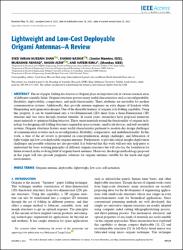| dc.contributor.author | Shah, Syed Imran Hussain | |
| dc.contributor.author | Bashir, Shahid | |
| dc.contributor.author | Ashfaq, Mubashir | |
| dc.contributor.author | Altaf, Ahsan | |
| dc.contributor.author | Rmili, Hatem | |
| dc.date.accessioned | 2021-08-05T10:25:11Z | |
| dc.date.available | 2021-08-05T10:25:11Z | |
| dc.date.issued | 2021 | en_US |
| dc.identifier.citation | Shah, S. I. H., Bashir, S., Ashfaq, M., Altaf, A. ve Rmili, H. (2021). Lightweight and low-cost deployable origami antennas-a review. IEEE Access, 9, 86429-86448. https://dx.doi.org/10.1109/ACCESS.2021.3088953 | en_US |
| dc.identifier.issn | 2169-3536 | |
| dc.identifier.uri | https://dx.doi.org/10.1109/ACCESS.2021.3088953 | |
| dc.identifier.uri | https://hdl.handle.net/20.500.12511/7690 | |
| dc.description.abstract | The art of paper folding also known as Origami plays an important role in various research areas of different scientific fields. Origami structures possess many useful characteristics such as reconfigurability, flexibility, deployability, compactness, and multi-functionality. These attributes are inevitable for modern communication systems. Additionally, they provide antenna engineers an extra degree of freedom while blueprinting next-generation designs. One of the desirable features of origami is its folding capability. Using this property, it can be transformed into a two-Dimensional (2D) sheet from a three-Dimensional (3D) structure and vice versa through external stimulus. In recent years, researchers have proposed numerous smart materials to optimize folding behavior. These smart materials extend the functionality of origami technology for designing self-folding structures required in space systems, small scale devices, and self-assembly systems. Origami structures feature many useful characteristics pertinent to modern day design challenges of communication systems such as reconfiguration, flexibility, compactness, and multifunctionality. In this work, a state of the art review is presented on conceptualization, design challenges, and fabrication of light-weight and low-cost deployable origami antennas. Furthermore, to provide critical insights deployment challenges and possible solutions are also provided. It is believed that this work will not only help peers to understand the basic working principles of different origami structures but will also lay the foundation for future research in the evolving field of origami-based antennas. Moreover, the design methodology proposed in this paper will also provide pragmatic solutions for origami antennas suitable for the harsh and rigid environments. | en_US |
| dc.description.sponsorship | Science and Technology Unit, King Abdulaziz University, Saudi Arabia | en_US |
| dc.language.iso | eng | en_US |
| dc.publisher | IEEE-Institute of Electrical and Electronics Engineers Inc. | en_US |
| dc.rights | info:eu-repo/semantics/openAccess | en_US |
| dc.rights | Attribution 4.0 International | * |
| dc.rights.uri | https://creativecommons.org/licenses/by/4.0/ | * |
| dc.subject | Origami Antenna | en_US |
| dc.subject | Deployable | en_US |
| dc.subject | Lightweight | en_US |
| dc.subject | Low Cost | en_US |
| dc.subject | Self-Actuation | en_US |
| dc.title | Lightweight and low-cost deployable origami antennas-a review | en_US |
| dc.type | review | en_US |
| dc.relation.ispartof | IEEE Access | en_US |
| dc.department | İstanbul Medipol Üniversitesi, Mühendislik ve Doğa Bilimleri Fakültesi, Elektrik ve Elektronik Mühendisliği Bölümü | en_US |
| dc.authorid | 0000-0002-5992-2718 | en_US |
| dc.identifier.volume | 9 | en_US |
| dc.identifier.startpage | 86429 | en_US |
| dc.identifier.endpage | 86448 | en_US |
| dc.relation.publicationcategory | Diğer | en_US |
| dc.identifier.doi | 10.1109/ACCESS.2021.3088953 | en_US |
| dc.identifier.wosquality | Q2 | en_US |
| dc.identifier.scopusquality | Q1 | en_US |



















